中国古典文学-英语ppt课件
- 格式:ppt
- 大小:133.00 KB
- 文档页数:5
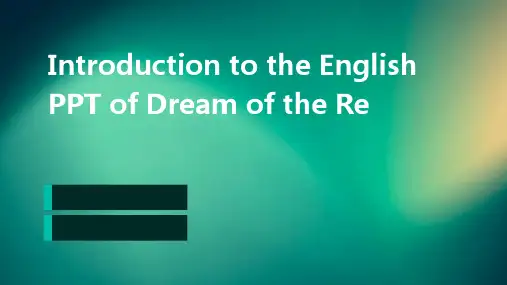
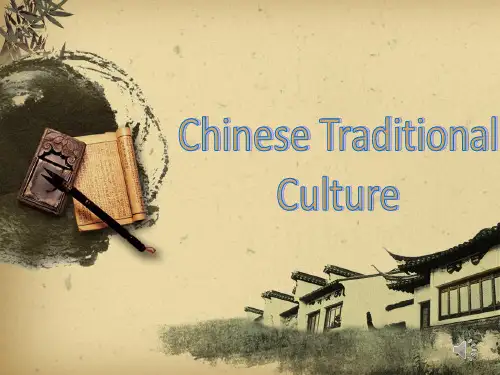

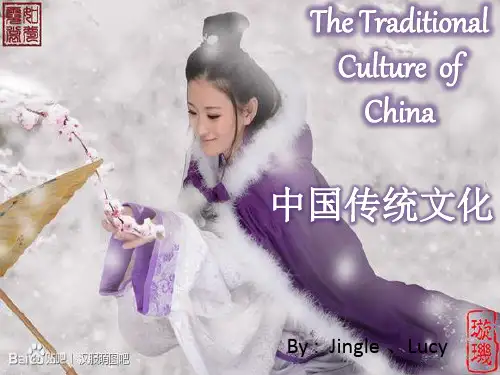

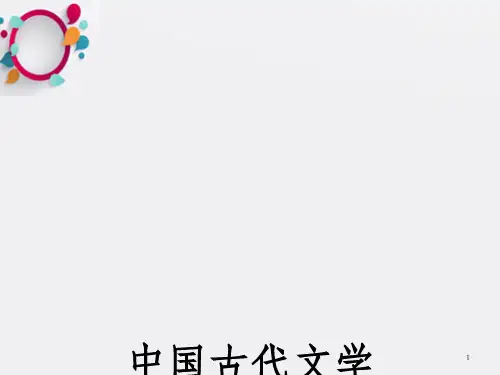
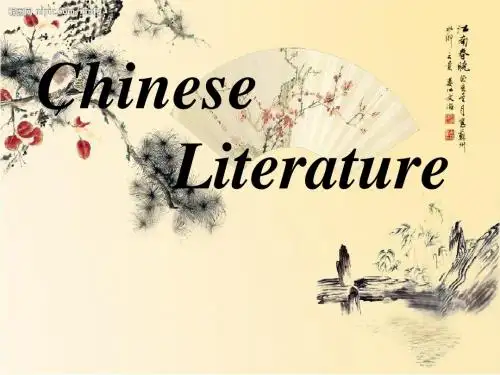
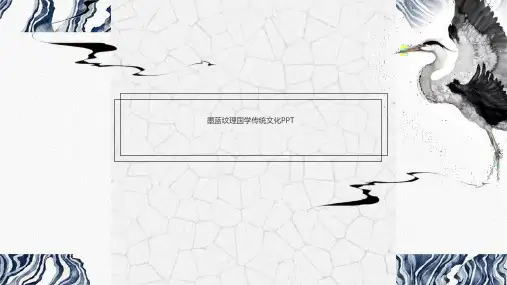
![中国文学英文介绍 Chinese Literature[优质ppt]](https://uimg.taocdn.com/c047bd759ec3d5bbfd0a74f0.webp)
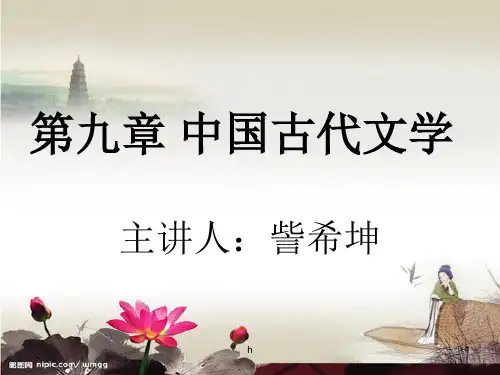
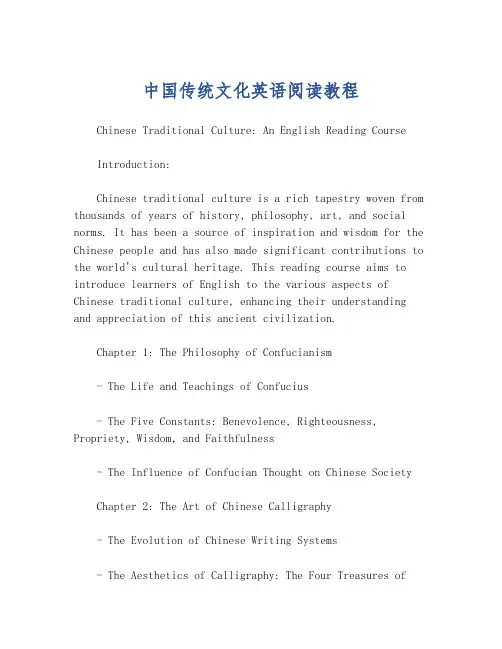
中国传统文化英语阅读教程Chinese Traditional Culture: An English Reading CourseIntroduction:Chinese traditional culture is a rich tapestry woven from thousands of years of history, philosophy, art, and social norms. It has been a source of inspiration and wisdom for the Chinese people and has also made significant contributions to the world's cultural heritage. This reading course aims to introduce learners of English to the various aspects of Chinese traditional culture, enhancing their understanding and appreciation of this ancient civilization.Chapter 1: The Philosophy of Confucianism- The Life and Teachings of Confucius- The Five Constants: Benevolence, Righteousness, Propriety, Wisdom, and Faithfulness- The Influence of Confucian Thought on Chinese SocietyChapter 2: The Art of Chinese Calligraphy- The Evolution of Chinese Writing Systems- The Aesthetics of Calligraphy: The Four Treasures ofthe Study- Masterpieces and Great Calligraphers of ChinaChapter 3: Traditional Chinese Medicine (TCM)- The Foundations of TCM: Qi, Yin, and Yang- The Practice of Acupuncture and Herbal Medicine- The Role of TCM in Modern HealthcareChapter 4: The Splendor of Chinese Opera- The Birth of Peking Opera and Its Characteristics- The Role of Music, Costume, and Makeup in Opera Performances- Famous Operas and Opera Stars of ChinaChapter 5: The Ancient Wisdom of Feng Shui- The Principles of Feng Shui and Its Application in Architecture- The Five Elements and the Bagua in Feng Shui- The Influence of Feng Shui on Interior Design and Landscape PlanningChapter 6: The Celebration of Chinese Festivals- The Significance of the Spring Festival (Chinese New Year)- The Lantern Festival, Dragon Boat Festival, and Mid-Autumn Festival- Traditional Foods and Customs Associated with Chinese FestivalsChapter 7: The Delicacies of Chinese Cuisine- The Eight Culinary Traditions of China- The Art of Chinese Cooking: Techniques and Ingredients- The Cultural Significance of Food in Chinese SocietyChapter 8: The Legacy of Chinese Inventions- The Four Great Inventions: Paper, Printing, Gunpowder, and the Compass- Contributions to Science, Technology, and the Arts- The Impact of Ancient Chinese Inventions on the WorldConclusion:Understanding Chinese traditional culture is not onlyabout learning facts and figures; it's about embracing a way of life that has been shaped by centuries of philosophical thought, artistic expression, and social development. This reading course is designed to be a stepping stone for English learners to delve deeper into the rich cultural heritage of China and to appreciate the profound impact it has had on the world.Glossary:- A comprehensive list of key terms and their definitions related to the topics covered in the course.Further Reading:- A selection of recommended books, articles, and websites for those who wish to explore Chinese traditional culture in greater depth.Acknowledgments:- Recognition of the scholars, authors, and cultural experts whose work has contributed to the creation of this reading course.。
中国文化英语教程ppt131、,Lead-in,Text study,Exercises,Unit 13 A SilentArmy,Lead-in,He you watched the Chinese Movie Myth 神话)? Some scenes near the end are shot in this fantastic place. Can you guess where it is?,Qin Shi Huangs mausoleum,Lead-in,Location: Lintong District, Xian, Shaanxi ProvinceAn UNESCO World Heritage S2、iteThe Eighth Wonder of the WorldA Collection of SculpturesThe Terracotta (赤陶土) Army or the “Terra Cotta Warriors and Horses”,Introduction,Discovery of the Terracotta Army (兵马俑),Vivid Sculpture,Text study,Introduction,the Terracotta Army of the First Emperor of Qin: Renowned as one of the “Eight Won3、ders of the World” Is a great legacy of his military might, and also a superb paradigm of ancient Chinesesculpture.,Introduction,The Terracotta Army is a collection of terracotta sculptures depicting the armies of Qin Shi HuangIt is a form of funerary art buried with the emperor in BC and wh4、ose purpose was to protect the emperor in his afterlife.,Discovery of the Terracotta Army,Discovery time: March 1974,Discovery of the Terracotta Army,Terra Cotta Pit No.1 was discovered by local villagers who were digging a well on a piece of barren land in Xianyang. They came across unusual pottery5、 fragments. Archaeologists soon uncovered on the site a huge army of terracotta warriors and horses. They were interred (埋葬) with the remains of the First Emperor over 2,000 years ago. Altogether four pits (坑) housing thousands of terracotta warriors he been unearthed.,Discovery of the Terracotta7、t 6,000 soldiers(wearing suits of armor and holding bronze weapons),Discovery of the Terracotta Army,On either side of central echelon, there is a row of 10 soldiers, as flanks (侧翼) of the formation,Discovery of the Terracotta Army,At the back, more than 100 warriors stand, probably part of the rea、r guard.,Among the formation are 32 terracotta horses, with four drawing a wooden war chariot (战车).,Discovery of the Terracotta Army,Pit No.2 was discovered in the summer of 1976.,Discovery of the Terracotta Army,二号坑蹲射佣出土时原状A crouching warrior, just unearthed from Pit No. 2, his martial bearing unta9、rnished by the soil still on his face.,Discovery of the Terracotta Army,It has 4 battle formations, including over 1,300 soldiers and horses, more than 0 war chariots and tens of thousands of bronze weapons.,Discovery of the Terracotta Army,Formation 1Eastern SectionsA group of archers (弓箭手)Front:10、60 archers , standing upright Back: 160 archers , squatting on one leg and kneeling on the other,Discovery of the Terracotta Army,Formation 2 (To the right of Formation 1)Aformation of 64 war chariots in rows.Each chariot is drawn by 4 life-size horses.Behind each chariot stand 3 soldiers: The on11、e in the middle-hold the reins; the other two on the sides hold long-staffed weapons,Discovery of the TerracottaArmy,Formation 319 chariots, 264 infantrymen (步兵) horsemenIn 3 rowsAt the front of each horse stands a soldier, with one hand holding the reins and the other in the pose of pulling a bow12、.,Discovery of the Terracotta Army,Formation 4 A formation of 10 horsemen and 10 saddled horses in 11rows,Discovery of the Terracotta Army,Pit No. 3 was also discovered in the summer of 1976. (West of Pit No.1)凹 shape, allest, only 6 warriors inside,Discovery of the Terracotta Army,Pit No.4 An13、 area of about 5,000 sq.m. located between No.2 and3,Vivid Sculpture,The terracotta warriors and horses caused a sensation upon their discovery, not only because of the impressive size of the army, but also due to the masterful craftanship of the sculptures.Two features Life-size: soldiers about14、1.5 meters tall; horses about 1.6 meters in height Various and distinctive:,Vivid Sculpture,Various and distinctive: vivid expressions; distinctive in terms of hairstyle, eyes, eyebrows, nose, lips, ears and beards, showing their individual age, position and personality.,Vivid Sculpture,The origina15、l figures were colorfully painted, but most of the color was lost after long years of burial.,Vivid Sculpture,跪射俑 Acrouching archer, in Pit No. 2, a fine example of sculptural art of the time,Half-squatting, half-kneeling Hair tied in a knot Suits of armor over war robes,The posture clearly shows t16、he tension of the process of shooting,Vivid Sculpture,立射俑头像 Head of a standing archer, in Pit No. 2 his eyes observing the enemy in the distance,Highly alert expressions: eyebrows lowered, nostrils slightly flaring ears alert,Vivid Sculpture,Horses (over 600),2 for pulling chariots One for17、 calrysteeds,Exercises,Comprehension,Communication,Application,Com prehension,l. Skimming and ScanningGo through the passage quickly and answer the following questions briefly. 1) What is the significance of the Terracotta Army of the First Emperor of Qin?It is not only a great legacy of the First1、 Emperor of Qins military might, but also a superb paradigm of ancient Chinese sculpture. 2) Which of the four pits is the largest? How large is it?Pit No. 1 is the largest, with an area of more than 14,000 square meters.,Comprehension,3) What are the four formations in Pit No.2?The four formations19、in Pit No. 2 are one of archers in the east, one of war chariots to its right, a bigger chariot formation in the middle and a formation of horsemen and saddled horses to the left.4) What was Pit No. 3 probably intended as?Pit No. 3 was probably intended as headquarters of the left, central and right21、 impressive size of the army and the masterful craftanship of the sculptures.,Comprehension,7) What is Paragraph 11 mainly about?Paragraph 11 is mainly about the detailed description of the sculptures, showing how vivid they are and how masterful the craftanship of the sculptures is.) How many22、terracotta horses are there in the three pits?There are more than 600 terracotta horses in the three pits.,Comprehension,II Careful Reading? 1. Read the passage carefully and choose the best answer to each of the following questions. From Paragraph 2, we can infer that _. A. the Terracotta Army was23、dug out by villagers in Xianyang B. the archeologists discovered the Terracotta Army by chance C. the warriors and horses were made of pottery D. the Terracotta Army was designed by the First Emperor,C,Comprehension,2) Which of the following is NOT found in Pit No. 1? _A. Soldiers. B. Commanders. C.24、 Archers. D. ChariotsThe formation of Pit No. I can be divided into _ main parts.A. 2 B. 3 C. 4 D. 5,C,B,Comprehension,4. One of the differences between Pit No. 2 and Pit No. 1 is that _. A. the former has more soldiers than the latter B. the former has more war chariots than the latter C. the soldi25、ers hold more modem weapons in Pit No. 2 D. the war chariot was drawn by horses in the former rather than by soldiers as in the latter.,B,Comprehension,5) Which of the following is NOT true about Pit No. 3? _A. It lies to the west of Pit No. l.B. It looks like in a 凹 shape.C. It has the least warrio26、rs among the four pits.D. It was not finished probably.6) The examples in Paragraph 12 are used to illustrate _. A. how vivid the warriors and horses are B. how impressive the size of the Terracotta Army is C. what kind of suits people wore at that time D. how attentive the soldiers were,C,A,Compreh27、ension,What is implied but not stated in Paragraph 12? Each of the archers hair was tied in a knot.The bows and arrows were preserved underground. C. The archers were waiting for the order to shoot. D. The archers were in the half-squatting and half-kneeling posture. ) The sculpture of the horses a29、arters,Communication,The following is a passage about the Terracotta Army. Read it and retell the sy in English.秦始皇从13岁开始,就为自己修建陵墓,这是一项浩大的工程。